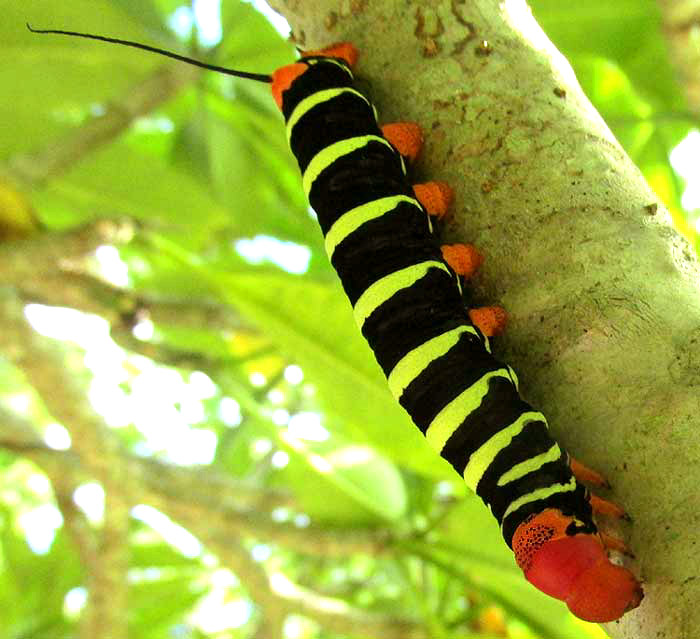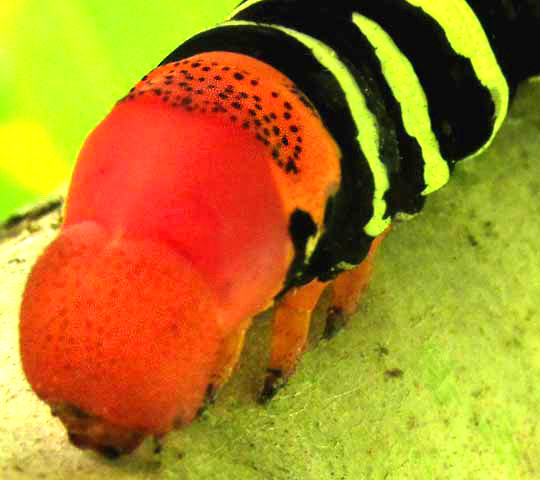Excerpts from Jim Conrad's
Naturalist Newsletter

from the October 18, 2015 Newsletter issued from Hacienda Chichen Resort beside Chichén Itzá Ruins; limestone bedrock; elevation ~39m (~128ft), N20.675°, W88.569°; central Yucatán state, MÉXICO
FRANGIPANI HORNWORM
Here at the peak of our rainy season, the Hacienda's Frangipani trees are as leafy and green as they'll get, though bearing hardly any flowers or fruit. Frangipanis are gorgeous, important ornamental trees planted worldwide, yet they're native to the Yucatan and found in our surrounding forests. You may want to review our Frangipani Page at www.backyardnature.net/mexnat/frangipa.htm.
During my afternoon garden-walks, when I pass a Frangipani, often it pays to search among the leaves, for lately one of the most boldly patterned and pretty of caterpillar species has been turning up there, the Frangipani Hornworm, PSEUDOSPHINX TETRIO. Above, one about as long as my finger is shown resting on the lower side of a succulent Frangipani stem.
A close-up of the caterpillar's very red head end, featuring an orange "collar" with curious black specks, is shown below:

When an animal with no obvious defenses such as sharp horns or pincers seems to go out of its way to draw attention to itself, a good bet is that either you have a very bad tasting or poisonous species, or one mimicking a bad tasting or poisonous species. Since Frangipanis copiously "bleed" a whitle, milky sap when injured, and the species is in the Dogbane Family, the Apocynaceae, known to embrace many poisonous plants, from the first I figured that these pretty Frangipani Hornworms must be full of deadly chemicals. When the caterpillars first turned up, my Internet connection was poor so I asked volunteer Bea in Ontario to see if she could find mention of such chemical defenses.
In her usual quick and efficient way, soon she'd emailed a page from the Internet reminding us that such color patterns are found everywhere throughout the insect world, from black and yellow-striped stinging wasps to black and red, bitter-tasting ladybird beetles, and brightly-colored, poisonous tropical butterflies. A fine technical word used to refer to conspicuous colors and patterns serving to warn is "aposematic."
The "Biodiversity in Belize" website describes a Squirrel Cuckoo -- a species fairly common here -- returning to a Frangipani Hornworm infested tree again and again for a meal. The bird would simply whack its caterpillars against a branch until the poisonous gut flew out, then it'd swallow the remains. Interestingly, this caterpillar-banging behavior seems to be genetically programmed in the Cuckoo taxonomical order, for anis (also in the order) also have been observed doing it, and here we have plenty of Groove-billed Anis, too.
The Belize page also describes a heavy infestation of Frangipani Hornworms that completely defoliated the shrubs they were feeding on, and after that began feeding on the main stems. Despite these caterpillars being able to eat up to three large leaves each day, generally even large numbers of caterpillars don't kill the plants, though they certainly can damage them. Frangipani Hornworms are so large and conspicuous that when outbreaks occur the best control for them is to simply look for them and pick them off.
When the Frangipani Hornworm metamorphoses, it produces a drab, brownish-gray sphinx moth as plain looking as the caterpillar is spectacular.